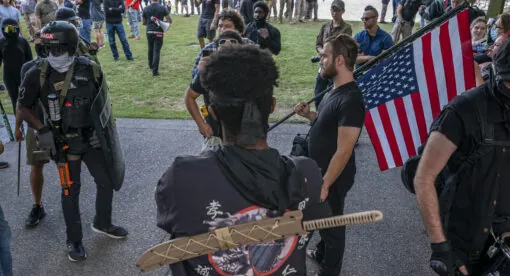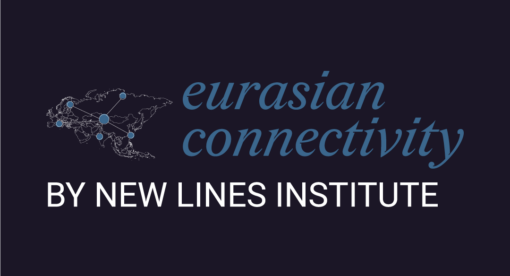The Weekly Forecast Monitor is a forward-looking assessment of geopolitical dynamics that are shaping the international system. To get more in-depth analysis of these issues and learn more about analytical products from New Lines Institute — including simulations, training sessions, and forecast reports — contact us at [email protected] and visit https://newlinesinstitute.org/analytical-products/. Download PDF version.
Global Hotspot Tracker
The Global Hotspot Tracker examines the outlook for key geopolitical hotspots around the world. (Go to the Global Connectivity Tracker)
Middle East
Summary – Tensions in the Middle East trended toward military and hybrid escalation scenarios after Iran carried out a direct drone and missile attack against Israel. Israel responded with drone strikes against an Iranian military base near Isfahan early Friday morning. Western countries began making plans to sanction Iran and list the Islamic Revolutionary Guard Corps as a terrorist organization. In a meeting between the U.S. and Israel on Thursday, the U.S. continued to express concerns of a major ground offensive in Rafah.
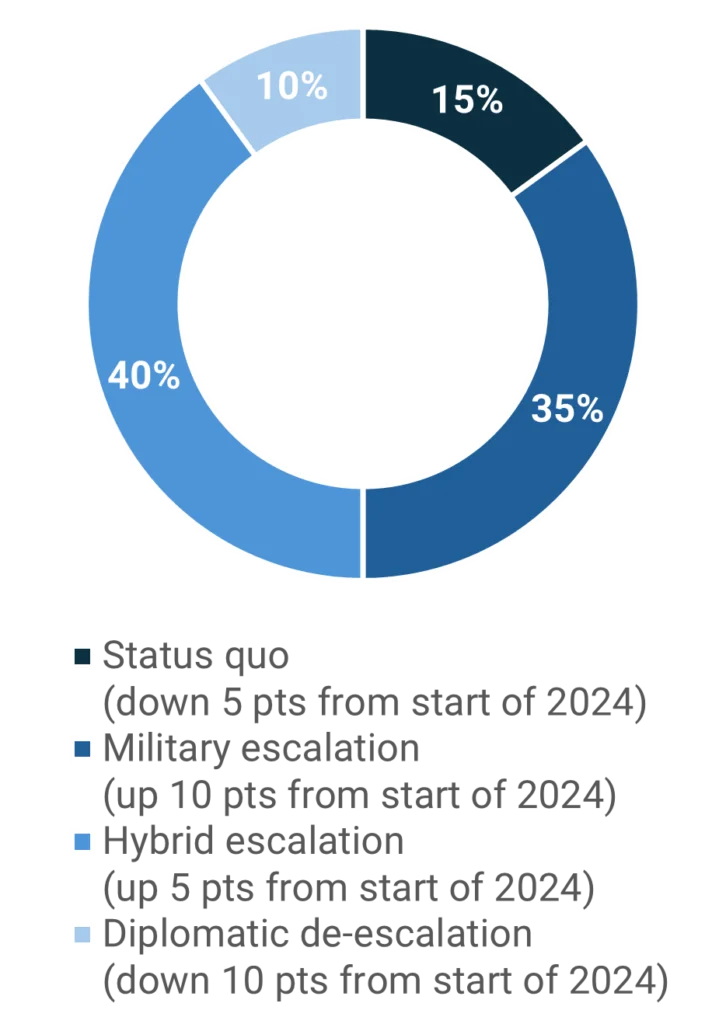
Military escalation scenario
- Iran carried out direct attacks against Israel, launching over 170 suicide drones, 30 cruise missiles, and 120 ballistic missiles. The Israel Defense Forces said 99% of the projectiles were intercepted.
Risk level – high - Israel retaliated with limited drone strikes on a military base near Isfahan. Iran downplayed the attack as an “infiltration.”
Risk level – medium/high - Egyptian officials reported Israel has decided to not carry out a major retaliation against Iran after the U.S. accepted Israeli plans for a Rafah offensive. The U.S. has denied the report.
Risk level – medium - The IDF carried out airstrikes against Hezbollah after 14 soldiers and four civilians were injured in a Hezbollah drone attack.
Risk level – medium/high
Hybrid escalation scenario
- The U.S. and European allies are expected to sanction Iran soon.
Risk level – medium/high - The IRGC seized a Portuguese-flagged, Israeli-affiliated container ship in the Gulf of Oman.
Risk level – medium/high
Diplomatic de-escalation scenario
- Gaza cease-fire talks continued with little progress. Qatari officials said negotiations are in a “delicate phase.” Qatar is reassessing its role as a primary mediator.
Opportunity level – low
Russia/Ukraine Conflict
Summary – The Russia-Ukraine conflict is trending toward military and hybrid escalation scenarios as Ukrainian officials warned of worsening conditions in the east and air defenses coming under strain from Russian bombings. The countries continue to attack each other’s critical and energy infrastructure with drones far from the front lines. U.S. House Speaker Mike Johnson moved to bring a Ukrainian funding package to a vote in the House by as early as this weekend, despite opposition from some Republican lawmakers.
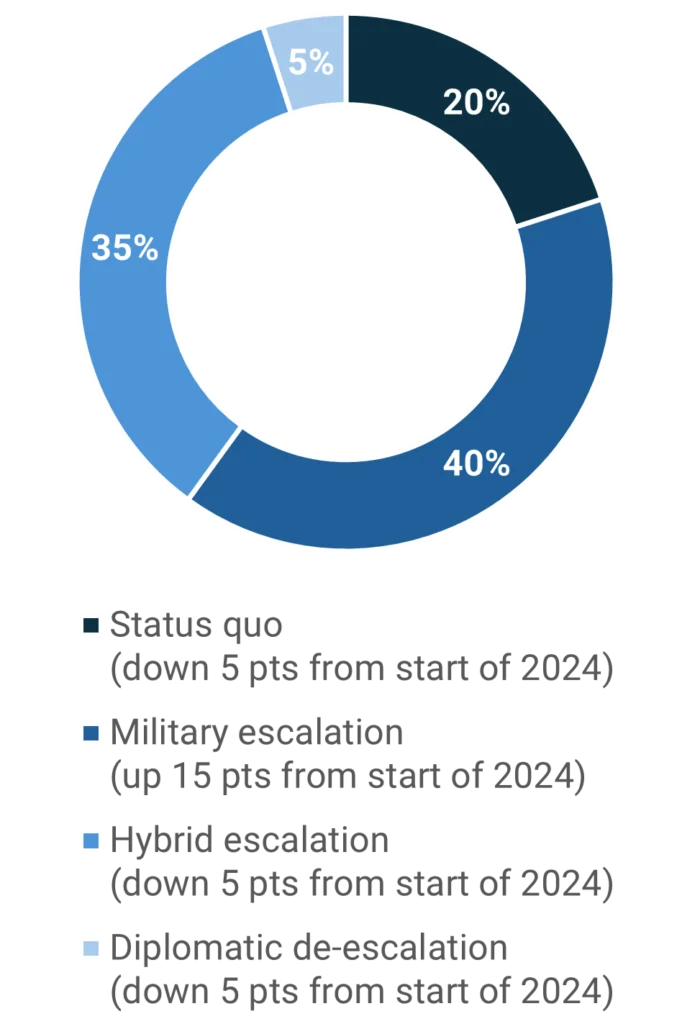
Military escalation scenario
- Ukrainian President Volodymyr Zelenskyy signed a bill into law that reforms the country’s mobilization rules to address troop shortages as Commander-in-Chief of the Ukrainian Armed Forces Oleksandr Syrskyi warned that the situation in the eastern front had worsened significantly.
Risk level – medium - G7 foreign ministers warned during a summit that Ukraine could be defeated by Russia if it doesn’t receive more air defense, while a senior Ukrainian presidential adviser warned that concentrated Russian bombing of Ukraine’s power stations is overwhelming its air defenses.
Risk level – medium - Maj. Gen. Enno Mõts, the Estonian Defense Forces chief of general staff, said Russia could break through in Kharkiv without a larger Ukrainian troop presence in the region.
Risk level – medium - Czech Prime Minister Petr Fiala said 20 countries had pledged to buy 500,000 artillery shells for Ukraine.
Risk level – low
Hybrid escalation scenario
- Two dual German-Russian citizens were arrested in Germany for allegedly planning acts of sabotage to undermine the country’s military support for Ukraine.
Risk level – low - Russian drones targeted critical infrastructure in Ivano-Frankivsk in Western Ukraine.
Risk level – low - Ukrainian drones targeted energy infrastructure in Tatarstan in central Russia.
Risk level – low
Diplomatic de-escalation scenario
- No major indicators
U.S./China/Indo-Pacific
Summary – Tensions in the Indo-Pacific trended toward military and hybrid escalation scenarios as the U.S. deployed a mid-range missile system to a northern Philippine island and President Joe Biden called for the tripling of tariffs on Chinese aluminum and steel. U.S. lawmakers would like to see the backlog of Harpoon missiles be delivered to Taiwan and have proposed allowing Taiwan to manufacture parts of U.S. weapon systems to avoid supply chain bottlenecks. A vote in the U.S. House of Representatives on military aid to Taiwan is expected this weekend.
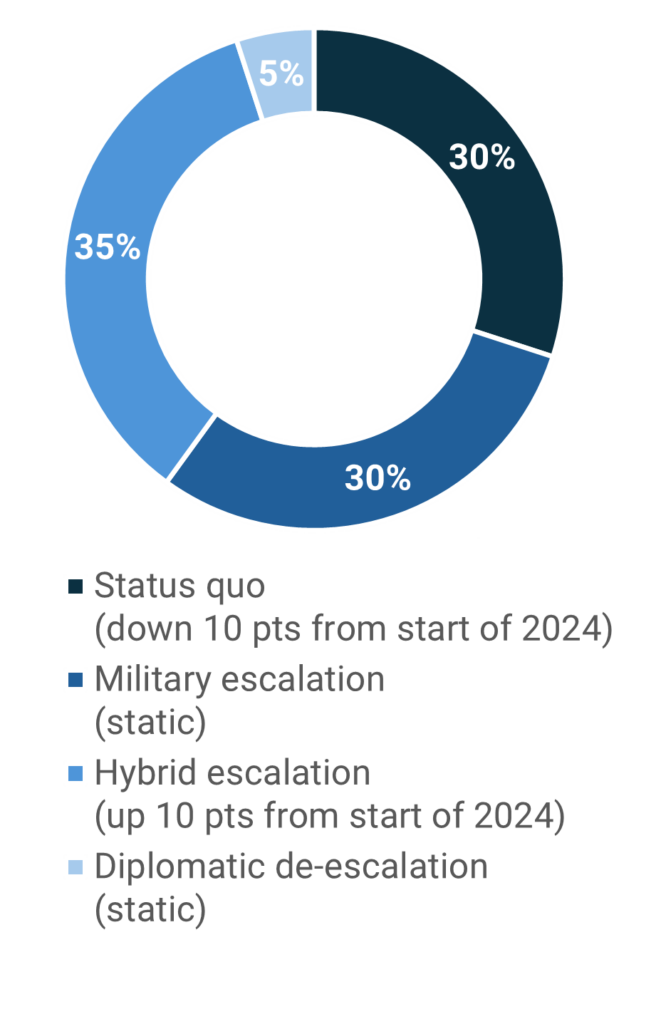
Military escalation scenario
- The U.S. Army announced deployment of a Typhoon weapons system to the northern Philippine island of Luzon. It is a mid-range capability system that could target mainland China. The announcement raises concerns China may increase militarization in the South China Sea.
Risk level – medium - U.S. Navy patrol aircraft flew through the Taiwan Strait, causing China to deploy fighter jets to monitor the patrol.
Risk level – low - Philippine President Ferdinand Marcos Jr. said the death of a Filipino serviceman caused by a foreign power would put into effect the U.S./Philippine Mutual Defense Treaty.
Risk level – low
Hybrid escalation scenario
- Biden called for tripling tariffs on Chinese steel and aluminum.
Risk level – medium - China announced new tariffs on propionic acid imports from the U.S.
Risk level – medium - After a petition from U.S. labor unions, the Office of the U.S. Trade Representative announced an investigation into China’s maritime, logistics, and shipbuilding sectors.
Risk level – medium
Diplomatic de-escalation scenario
- No major indicators.
Global Connectivity Tracker
The Global Connectivity Tracker examines the impact of geopolitical dynamics on global energy security and the climate transition. (Go to the Global Hotspot Tracker)
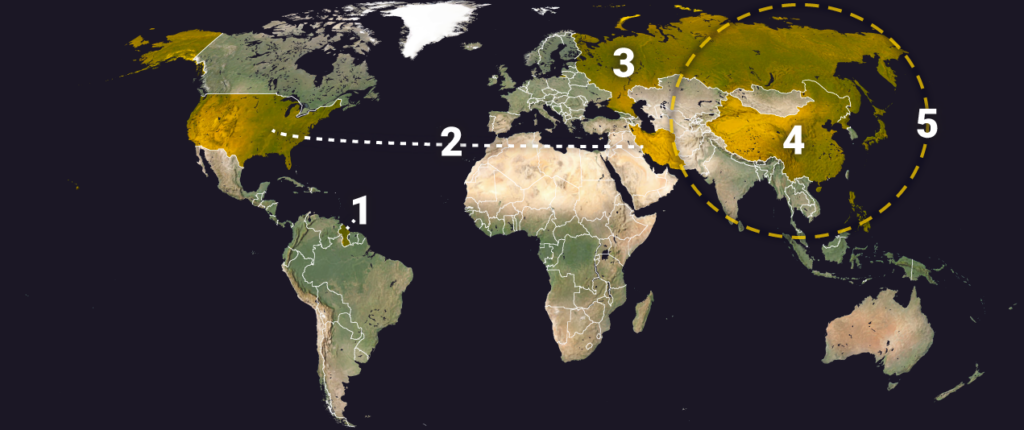
Energy/Climate
- Guyana
What happened: Guyana will produce more crude oil than OPEC member Venezuela after Exxon Mobil Corp. approved its Whiptail oil development project.
Significance/Outlook: Eight years after oil production began, Guyana’s daily crude capacity will reach 1.3 million barrels. Guyana’s expansion as an oil producer has huge social and economic effects for the country and comes as Venezuela, a co-founder of OPEC, struggles with underinvestment and international sanctions that cut oil production and government earnings. Exploring for oil in a territory claimed by both Guyana and Venezuela may escalate hostilities and geopolitical tensions. Venezuela may also use force against ExxonMobil over offshore Guyana drilling.
Opportunity level – medium - Iran/U.S.
What happened: Iran’s drone attack on Israel on Saturday has not yet prompted the U.S. to impose energy sanctions against Iran.
Significance/Outlook: Increased oil prices could damage President Joe Biden in the upcoming U.S. presidential election due to the effect it could have on U.S. gasoline prices. In addition, China is the biggest importer of Iranian oil, and targeting the oil sector in Iran would in turn impact the Chinese economy. Potential secondary sanctions could include major Chinese companies and banks, which could deteriorate already destabilized U.S.-China relations. Not imposing further energy sanctions could be seen as a measure to pressure Israel against further escalation in the region.
Risk level – low
- Russia
What happened: Russia has restored some oil refinery equipment that had been damaged in Ukrainian drone strikes, raising its refining capacity.
Significance/Outlook: Drone attacks by Ukraine have damaged many Russian refineries in recent weeks, affecting both production capacity and exports. The strikes initially reduced Russian capacity by 907,000 barrels per day (around 14% of its capacity), but the repairs have reduced that capacity gap to 660,000 barrels per day (around 10%). Distillate shipments will be affected immediately. To prevent Russian retaliation and oil price hikes, the U.S. repeatedly urged Ukraine to discontinue its drone assaults on Russian oil installations.
Risk level – low/medium - China
What happened: China is developing more nuclear energy capacity to fulfill its growing energy needs using cleaner sources.
Significance/Outlook: With China’s increased electricity demand, the country is increasing its investments in the nuclear energy sector. As of September 2023, China had 55 operational nuclear power units totaling 57 GW in installed capacity and 24 units under construction with a combined installed capacity of 27.8 GW. This capacity is expected to rise dramatically in the future, especially with China’s advanced technologies and comparative advantage to the United States and most other countries in terms of the cost of building power plants. This step will aid the country in achieving its net-zero emission goals while securing energy needs.
Opportunity level – medium - Asia
What happened: Liquefied natural gas (LNG) prices reached their highest in Asia since January 2024 amid rising conflicts in the Middle East.
Significance/Outlook: LNG spot prices have risen above $11 per million BTUs and are expected to rise further if escalation continues. A potential escalation between Iran and Israel could disrupt LNG cargo flows around the Strait of Hormuz through which one-fifth of global LNG commerce passes, adding to the complexity of sea lane security in the region. Although the probability of closing the strait is low, the likelihood of disruption is expected.
Risk level – low/medium
Key Stats of the Week
- Iran’s oil exports were in the range of 1.6 million-1.8 million barrels a day in the first quarter of 2024, which is close to the 2 million barrels a day Iran exported prior to U.S. sanctions.
Source: Reuters



